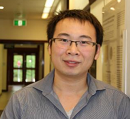Contents
Host

Asst. Prof. Zibin Chen
Junior Executive Editor of Microstructures
Department of Industrial and Systems Engineering, The Hong Kong Polytechnic University, Hong Kong, China.
Department of Industrial and Systems Engineering, The Hong Kong Polytechnic University, Hong Kong, China.
Speaker

Dr. Patrick Trimby
Oxford Instruments Nanoanalysis, High Wycombe, United Kingdom
Patrick Trimby studied geology at Oxford University and completed his PhD in 1998 at the University of Liverpool in the UK, focusing on the application of the emerging technique of electron backscatter diffraction (EBSD) to the study of deformed rocks. Following a postdoctoral position at Utrecht University in the Netherlands, he worked for the next 10 years at HKL Technology in Denmark and subsequently Oxford Instruments in Sweden, before moving to the University of Sydney in Australia in 2010. During his time in Australia, Dr. Trimby played a prominent role in the development of Transmission Kikuchi Diffraction (TKD) and was involved in a wide range of microstructural research, ranging from atom probe tomography of meteorites to the characterisation of severely plastically deformed alloys in the scanning electron microscope. Since 2017, Dr. Trimby has been the EBSD Product Manager at Oxford Instruments Nanoanalysis in the UK and has overseen the launch of the world’s first CMOS-based EBSD detector, as well as multiple innovations in EBSD data processing techniques. Dr. Trimby has published more than 70 peer-reviewed articles and presented at international conferences across the world, often as a plenary / keynote speaker. He is constantly looking to continue the development of the EBSD technique and is routinely involved in multiple collaborative research projects with customers, spanning a wide range of applications from battery technologies to solar cell research and development.
Introduction
Electron backscatter diffraction (EBSD) in the scanning electron microscope (SEM) is an accepted standard characterisation technique that provides orientation, phase and texture information on the sub-micrometre to centimetre scale. Increasingly researchers are using EBSD on ever more challenging materials, such as metals that have undergone severe plastic deformation (SPD) or organic thin films used for solar cell research. These applications place particular challenges on the process of characterisation using EBSD; for example, high defect densities in SPD materials can prevent the collection of indexable diffraction patterns, or the analysis of single dislocations in semiconductor thin films typically requires exceptionally high angular precision.
Conventional EBSD pattern indexing, via the detection of Kikuchi band positions using the Hough image transform, is fast and highly optimised but is not suitable for many such challenging applications. The development of alternative approaches, involving high-quality diffraction pattern simulations coupled with pattern matching methods, is now having a profound effect on the application of EBSD to a wide range of materials characterisation challenges. These new approaches can deliver high quality data from even the most severely deformed structures, they can measure the small orientation shifts associated with single dislocations and they can even resolve changes in polarity or chirality in certain structures. In this webinar an overview of these newly-developed EBSD pattern matching methods will be presented, along with examples showing how they are driving significant advances across a range of research fields, including for the characterisation of deformed materials, the measurement of structures in thin films and electronics materials and even for the successful analysis of complex, multi-phase meteorites.
Conventional EBSD pattern indexing, via the detection of Kikuchi band positions using the Hough image transform, is fast and highly optimised but is not suitable for many such challenging applications. The development of alternative approaches, involving high-quality diffraction pattern simulations coupled with pattern matching methods, is now having a profound effect on the application of EBSD to a wide range of materials characterisation challenges. These new approaches can deliver high quality data from even the most severely deformed structures, they can measure the small orientation shifts associated with single dislocations and they can even resolve changes in polarity or chirality in certain structures. In this webinar an overview of these newly-developed EBSD pattern matching methods will be presented, along with examples showing how they are driving significant advances across a range of research fields, including for the characterisation of deformed materials, the measurement of structures in thin films and electronics materials and even for the successful analysis of complex, multi-phase meteorites.
Moments








Presentation

Introduction of Microstructures and Speaker
NaN

Report
NaN

Discussion
NaN











